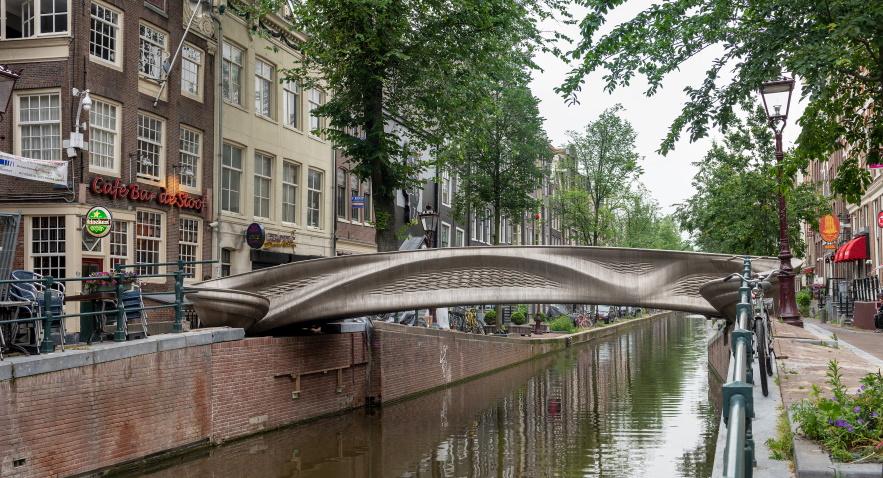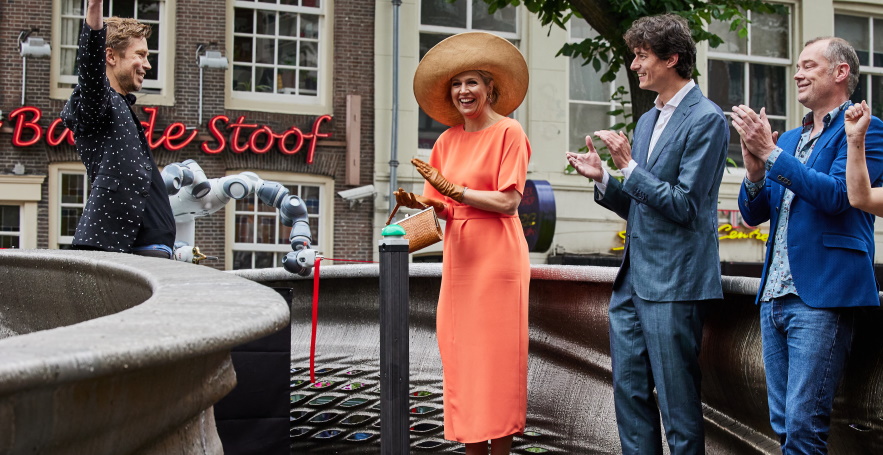
Submitted by Simone Castello on Fri, 23/07/2021 - 09:17
An article in The New Scientist - ‘World's first 3D-printed steel bridge opens in Amsterdam’ - celebrates an innovative four-year project involving a collaboration between CSIC and The Alan Turing Institute.
The 3D-printed steel bridge was unveiled last week by Queen Máxima of the Netherlands, who cut the ribbon with the aid of a robotic arm, a witty reference to the technology deployed to create the structure.
The 12m-long bridge, made of 4500kg of stainless steel, was built by industrial robots using welding torches, which created the structure layer by layer. It was printed by Dutch company MX3D and took six months to complete.
The bridge was carefully transported to its central location over the Oudezijds Achterburgwal canal in early July and opened to pedestrians and cyclists.
MX3D Bridge Placement 2021
Placement of the 3D-printed bridge, video by Anita Star, courtesy of MX3D
Sensors and digital twin technologies monitor structural health
More than a hundred sensors are attached to the bridge to monitor strain, movement, vibrations and weather conditions as people cross it. The data collected will be sent to a digital twin of the bridge, which will help engineers assess how the bridge is faring, alerting them if problems occur and when maintenance might be required.
The data will also provide input and lessons learned for future builds, helping designers understand how 3D-printed steel could be used in more complex projects. Statistical methodology will be utilised to understand more about the material itself.
Professor Mark Girolami, Sir Kirby Laing Professor of Civil Engineering and Royal Academy of Engineering Research Chair at the University of Cambridge, Academic Lead for CSIC and Director of the Data-centric Engineering Programme at The Alan Turing Institute, who led the overall project, is currently working on the bridge’s digital twin with his team of researchers at both Cambridge and the Turing. Machine learning will be used to spot trends in the data pointing to potential changes, issues of maintenance or necessary modifications.
Queen Máxima of the Netherlands cuts the ribbon with the aid of a robotic arm
Genesis of the 3D-printed bridge
Dr Mohammed Elshafie, CSIC Co-Investigator, has been collaborating with The Data Centric Engineering Programme at The Alan Turing Institute, and the 3D-printing company MX3D to measure, monitor and analyse the performance of the bridge.
The innovative sensor network was designed and installed by a team from the Turing Data centric Engineering Programme, which was comprised of structural engineers, mathematicians, computer scientists and statisticians, including CSIC researchers. Dr Liam Butler, a former CSIC Research Associate and now Assistant Professor at the Lassonde School of Engineering (Civil Engineering) at York University, Toronto, Canada, provided the expertise for the bridge’s sensor network.
In a previous article published on the CSIC website reporting on the development of the bridge, Dr Elshafie said: “The sensor network provides a ‘nervous system’ for the bridge and creates a living laboratory for the researchers and engineers”.
The data from the sensors will be sent to the digital twin of the bridge, a living computer model that is being developed by the CSIC team at Cambridge. Professor Girolami commented: “To deliver a Digital Twin of the structure we had to fundamentally reinvent the structural modelling tools to enable the synthesis of data from the actual bridge.” This work was reported in a landmark paper in the Proceedings of the National Academy of Sciences previously reported in CSIC news.
While the project was still underway, Prof Girolami commented: “The 3D printed bridge being installed by the MX3D team next year will be a world first in engineering. This data-centric, multidisciplinary approach to capturing the bridge’s data will also mark a step-change in the way bridges are designed, constructed, and managed, generating valuable insights for the next generation of bridges and other major public structures.”
Other stakeholders in the project include software engineers Autodesk, FORCE Technology, Lenovo, HBM and The Amsterdam Institute for Advanced Metropolitan Solutions, while the build of the bridge has been supported by the Lloyd’s Register Foundation.
MX3D has been working on the 3D-printed bridge since 2015, collaborating with various partners, including Joris Laarman Lab who designed the bridge, Arup who acted as the project’s lead structural engineers and Autodesk, which provided their knowledge on digital production tools.
An article by The Alan Turing Institute, entitled “Bridging the gap between physical and digital” details the milestones of the project. The Turing’s Data-Centric Engineering programme became involved in the project when the concept of a ‘digital twin’ was introduced, while Imperial College were brought on board because of its “strong interest in exploring new 3D printing techniques”. It offered the expertise of its Steel Structures Research Group in material testing and modelling. Chris Oates, a Turing Fellow from Newcastle University, investigated the material properties of 3D-printed steel through statistical methodology. Eric Daub, Principal Research Data Scientist at the Turing, joined the team to help develop the code for the digital twin.
The project is a successful example of how multi-disciplinary collaborations and synergies among academia, industry and public authorities can harness technological innovation to improve efficiency and longevity of infrastructure in cities.
- Read more: https://www.newscientist.com/article/2283934-worlds-first-3d-printed-steel-bridge-opens-in-amsterdam/#ixzz71347Rsbx
- Background information for this article comes from two previous articles about the project: Sensors make the world’s first 3D printed steel bridge a ‘living laboratory’ https://www-smartinfrastructure.eng.cam.ac.uk/news-and-events/sensors-make-the-world2019s-first-3d-printed-steel-bridge-a-2018living-laboratory2019 and Bridging the gap between physical and digital https://www.turing.ac.uk/research/impact-stories/bridging-gap-between-physical-and-digital
Photos and video by kind permission of MX3D. Photographers: Thea van den Heuvel and Jan de Groen. Videographer: Anita Star.

